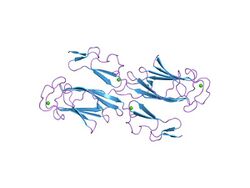Biology:Calcium-binding EGF domain
| Calcium-binding EGF domain | |||||||||
|---|---|---|---|---|---|---|---|---|---|
 crystal structure of the human mbl-associated protein 19 (map19) | |||||||||
| Identifiers | |||||||||
| Symbol | EGF_CA | ||||||||
| Pfam | PF07645 | ||||||||
| Pfam clan | CL0001 | ||||||||
| InterPro | IPR013091 | ||||||||
| CDD | cd00054 | ||||||||
| |||||||||
In molecular biology, the calcium-binding EGF domain is an EGF-like domain of about forty amino-acid residues found in epidermal growth factor (EGF). This domain is present in a large number of membrane-bound and extracellular, mostly animal, proteins.[1][2][3][4][5] Many of these proteins require calcium for their biological function and a calcium-binding site has been found at the N-terminus of some EGF-like domains.[6] Calcium-binding may be crucial for numerous protein-protein interactions.
For human coagulation factor IX it has been shown that the calcium-ligands form a pentagonal bipyramid.[7] The first, third and fourth conserved negatively charged or polar residues are side chain ligands. The latter is possibly hydroxylated.[6] A conserved aromatic residue, as well as the second conserved negative residue, are thought to be involved in stabilising the calcium-binding site.
As in non-calcium binding EGF-like domains, there are six conserved cysteines and the structure of both types is very similar as calcium-binding induces only strictly local structural changes.[6]
References
- ↑ Davis CG (May 1990). "The many faces of epidermal growth factor repeats". New Biol. 2 (5): 410–9. PMID 2288911.
- ↑ "Vaccinia virus 19-kilodalton protein: relationship to several mammalian proteins, including two growth factors". Proc. Natl. Acad. Sci. U.S.A. 81 (23): 7363–7. December 1984. doi:10.1073/pnas.81.23.7363. PMID 6334307. Bibcode: 1984PNAS...81.7363B.
- ↑ "[Similar domains in different proteins: detection and significance]" (in ja). Tanpakushitsu Kakusan Koso (29 Suppl): 54–68. June 1986. PMID 3534958.
- ↑ "Computer-based characterization of epidermal growth factor precursor". Nature 307 (5951): 558–60. 1984. doi:10.1038/307558a0. PMID 6607417. Bibcode: 1984Natur.307..558D.
- ↑ "Structure and function of epidermal growth factor-like regions in proteins". FEBS Lett. 231 (1): 1–4. April 1988. doi:10.1016/0014-5793(88)80690-2. PMID 3282918. https://zenodo.org/record/1253880.
- ↑ 6.0 6.1 6.2 "How an epidermal growth factor (EGF)-like domain binds calcium. High resolution NMR structure of the calcium form of the NH2-terminal EGF-like domain in coagulation factor X". J. Biol. Chem. 267 (27): 19642–9. September 1992. doi:10.2210/pdb1ccf/pdb. PMID 1527084.
- ↑ "The structure of a Ca(2+)-binding epidermal growth factor-like domain: its role in protein-protein interactions". Cell 82 (1): 131–41. July 1995. doi:10.1016/0092-8674(95)90059-4. PMID 7606779.
 |

